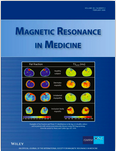 The purpose of this study was to develop a fast MR fingerprinting (MRF) sequence for simultaneous estimation of water T1 (T1H2O ) and fat fraction (FF) in fat infiltrated skeletal muscles.
The purpose of this study was to develop a fast MR fingerprinting (MRF) sequence for simultaneous estimation of water T1 (T1H2O ) and fat fraction (FF) in fat infiltrated skeletal muscles.
The MRF sequence for T1H2O and FF quantification (MRF T1-FF) comprises a 1400 radial spokes echo train, following nonselective inversion, with varying echo and repetition time, as well as prescribed flip angle. Undersampled frames were reconstructed at different acquisition time-points by nonuniform Fourier transform, and a bi-component model based on Bloch simulations applied to adjust the signal evolution and extract T1H2O and FF. The sequence was validated on a multi-vial phantom, in three healthy volunteers and five patients with neuromuscular diseases. The authors evaluated the agreement between MRF T1-FF parameters and reference values and confounding effects due to B0 and B1 inhomogeneities.
In phantom, T1H2O and FF were highly correlated with references values measured with multi-inversion time inversion recovery-stimulated echo acquisition mode and Dixon, respectively (R2 > 0.99). In vivo, T1H2O and FF determined by the MRF T1-FF sequence were also correlated with reference values (R2 = 0.98 and 0.97, respectively). The precision on T1H2O was better than 5% for muscles where FF was less than 0.4. Both T1H2O and FF values were not confounded by B0 nor B1 inhomogeneities.
The MRF T1-FF sequence derived T1H2O and FF values in voxels containing a mixture of water and fat protons. This method can be used to comprehend and characterize the effects of tissue water compartmentation and distribution on muscle T1 values in patients affected by chronic fat infiltration.
